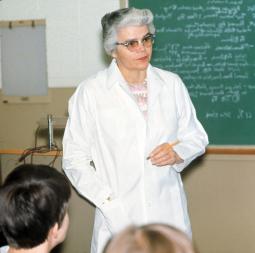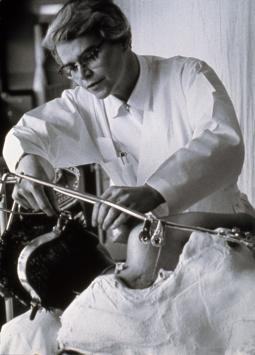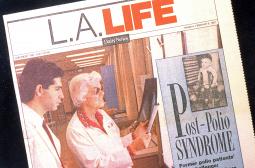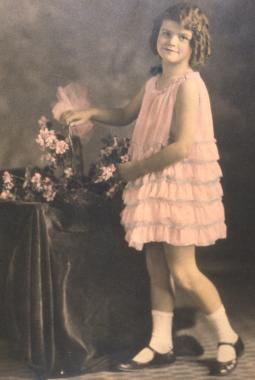Polio Place
A service of Post-Polio Health International
Jacquelin Perry, MD, DSc (Hon)
Born: May 31, 1918
Died: March 11, 2013
Major Contribution:
Known among her peers as the Grande Dame of Orthopaedics, Dr. Jacquelin Perry was one of the first ten women to be certified by the American Board of Orthopedic Surgery. She broke new ground in laboratory research by becoming the country’s foremost expert on gait analysis. She is co-author, with Judith Burnfield, of Gait Analysis: Normal and Pathological Function, the classic text on gait analysis.
In the early 1950s, she jump-started the surgical program for post-poliomyelitis patients at Los Angeles’ Rancho Los Amigos Medical Center. The medical staff was looking for ways to provide stability for the more significantly disabled polio patients who had paralysis of the neck and trunk. Recognizing that bracing was not adequate, she, along with Dr. Vernon Nickel, pioneered the use of halos for spinal surgery and rehabilitation.
Perry’s contributions to the body of knowledge of understanding human movement included studying all forms of functional assists from canes, to crutches, braces and wheelchairs. She compared the effectiveness of various forms of bracing and prostheses, total joint replacements, resection arthroplasty and other surgical interventions. She also studied the effects of injury in both professional and recreational athletes.
Other Information:
Brief Bio: Jacquelin Perry was born in Denver, Colorado, but was raised in Los Angeles, California, the only child of a clothing-shop clerk and a traveling salesman. She recalls, “I knew at about age 10 that I wanted to be a doctor. I read every medical book in the Los Angeles library.” (1) She received her bachelor’s degree in Physical Education at the University of California, Los Angeles in 1940. Next, she joined the army and trained to be a physical therapist, receiving a certificate from Walter Reed Army General Hospital in Washington, D.C.
She completed a two-year assignment at Hot Springs, Arkansas, and that military experience gave her a strong background in poliomyelitis and arthritis. After World War II, she used the G.I. Bill to study medicine and became the first woman orthopaedic surgeon to graduate from the University of California, San Francisco. Like many orthopaedic surgeons, she was skilled with hand tools and improvised and built many of the rehabilitation devices she used with her patients.
In a published profile in the American Academy of Orthopaedic Surgeons, Dr. Perry said,
“It was definitely not a field for women back then. People said it was too strenuous. Too mechanical. My medical school class had 10% women - seven out of seventy-six, pretty good numbers for those days. Orthopaedic surgery wasn't very popular in those days, it was mostly braces and buckles, not the surgical specialty it is today." (2)
In 1955, she joined the medical staff at Rancho Los Amigos and was Chief of the Pathokinesiology Service for 30 years. She once stated that her polio experience at Rancho broadened her medical experience (and that of others) because they developed a team concept of patient care; nurses and therapists were encouraged by the physician to take responsibility for evaluation and treatment planning. (3)
She was honored with “Woman of the Year for Medicine” in Southern California by the Los Angeles Times in 1959.
When polio patients started coming back to her with post-polio symptoms in the late ‘70s, she counseled them not to push themselves but to modify their lifestyles and implement energy conservation techniques in order to accommodate their new reality. In an article called General Information Letter for Polio Survivors: Why are "old polios" who were stable for years now losing function? What should they do about it? SPANISH, Perry advises, "Be an "Intelligent Hypochondriac" – Listen to your body and adopt a program that avoids the strain."
Her publications, noted for their rigorous scientific standards, reflect her particular concern for patients with many conditions, such as multiple sclerosis, cerebral palsy and stroke, and individuals with spinal cord injury and amputation. In addition to the well-known gait textbook, she co-authored more than 400 peer-reviewed papers and 38 book chapters.
Her 50-year career is reflected in the many awards and teaching positions she has held. She founded the Scoliosis Research Society and was a board member of numerous professional societies. Credentials for Dr. Perry include board certification in Orthopaedic Surgery, membership of the American Academy of Orthopaedic Surgeons, American Orthopaedic Association, American Institute for Medical Biological Engineering, Western Orthopaedic Association, California Medical Association, Los Angeles County Medical Association, American Physical Therapy Association (honorary lifetime membership), Scoliosis Research Society (Emeritus), LeRoy Abbott Society, American Academy for Cerebral Palsy and Development Medicine, American Academy of Orthotists and Prosthetists (honorary membership), Ruth Jackson Society and Gait and Clinical Movement Analysis Society.
Dr. Perry’s numerous awards, accolades, professional activities and visiting professorships have influenced many outreach programs for female students in the fields of orthopeadic surgery, physical therapy and mechanical engineering (such as the “The Perry Initiative” and the Jacquelin Perry, MD, Resident Research Award).
The Jacquelin Perry Neuro-Trauma Institute and Rehabilitation Center at Rancho Los Amigos was dedicated in 1996 in her honor. At the ceremony she remarked, “It amazes me that I should be honored for doing the very things I enjoy.”
In 2000, PHI honored Dr. Perry at its 8th International Post-Polio and Independent Living Conference held in St. Louis, Missouri. She, along with Dr. Augusta Alba, was recognized for her dedicated years of supporting polio survivors by combining her medical expertise with practical advice.
She stopped performing surgeries in the late 1960s as the result of a brain artery blockage, but continued doing research focused on gait. Perry, who later developed Parkinson's disease, continued practicing into her nineties. She died in March of 2013 at the age of 94 (see Los Angeles Times obituary).
1. From text of Honorary Award presented in June 2000 by PHI.
2. From "Rancho's Angel" in Moving Stories: 75 Years of Orthopaedics.
3. From text of Honorary Award presented in June 2000 by PHI.
Description of publications:
See “Major Article” tab
For a full listing of her Dr. Jacqueline Perry’s life work see her Curriculum Vitae.
Hear an audio clip of Dr. Perry being interviewed by the American Academy of Orthopedic Surgeons.
2006 interview with Dr. Perry by Neena Bhandari of India Voice
May 2012/Carol K. Elliott & Joan L. Headley/Post-Polio Health International
Major Articles: Jacquelin Perry, MD, DSc (Hon)
Textbook:
Jacquelin Perry MD and Judith Burnfield, PhD, Gait Analysis: Normal and Pathological Function, (second edition ) Function New Jersey: Slack Incorporated, 2010.
Medical Journal Articles:
Elective Surgery On Patients With Respiratory Paralysis. Nickel, V. L., Perry, J., Affeldt, J. E., and Dail, C. W. J. Bone Joint Surg 1957; 39A:989-1001.
Intensive rehabilitation. Recent experience in a chronic disease hospital. Affeldt, J. E., Nickel, V. L., Perry, J., and Kriete, B. C. California Medicine, 1959: 91: 193-196.
Selective Stretching for the Paralytic Patient. Adkins, H. V., Robbins, V., Eckland, F., Perry, J., and Nickel, V. L.. Physical Therapy, 1960: 40:644-648.
Application of the halo. Snelson, R., Nickel, V. L., Perry, J., and Garrett, A. L. Prosthetic Appliance Journal, 1960: 14:31-35.
Stabilization of the Collapsing Spine. Garrett, A. L., Perry, J., and Nickel, V. L. J. Bone Joint Surg., 1961: 43A:474-484.
Paralytic scoliosis. Garrett, A. L., Perry, J., and Nickel, V. L. Clin.Orthop. Rel. Res., 1961: 21: 117-124,.
Scoliosis: Some Recommendations. Perry, J. J Am Med Wom Assoc., 1962: 17-19:725-727.
Capital Fascial Transplants Adjunct to Spine Fusion in Flaccid Neck Paralysis. Perry, J., Nickel, V. L., Garrett, A. L. Clin. Orthop. Rel. Res., 1962: 24:128-136.
Development of useful function in the severely paralyzed hand. Nickel, V. L., Perry, J., Garrett, A. L. J. Bone Joint Surg., 1963: 45A:933-952.
Professionalism in Physical Therapy. Perry, J. Phys. Ther., 1964: 44(6): 429-434.
The Contribution of the Physical Therapist To Medicine. Perry, J. Phys. Therapy., 1965: 45(11):1033-1041.
Orthopedic Management of the Lower Extremity in the Hemiplegic Patient.. Perry, J. Phys. Therapy, 1966: 46:345-356.
The Mechanics of Walking: A Clinical Interpretation. Perry, J. Phys.Ther., 1967:47(9):777-801.
Principles of Lower-Extremity Bracing. Perry, J., Hislop, H. J. New York, American Physical Therapy Association, 1967.
Bracing in Hemiplegia. The lower extremity. Perry, J. Prosthet. Orthot., 1968: Int. 3:27-31.
The Mechanics of Walking in Hemiplegia .Perry, J.:. Clin. Orthop. Rel. Res. 63:23-31, 1969.
Lower-Extremity Bracing In Hemiplegia. Perry, J.: Clin. Orthop. Rel. Res, 1969: 63:32-38.
Halo in Spinal Abnormalities: Practical Factors And Avoidance Of Complications. Perry, J. Orthopedic Clinics of North America, 1972: 3(1):69-80.
Kinesiology of Lower Extremity Bracing. Perry, J. Clin. Orthop. Rel.Res., 1974: 102:18-31.
The Relative Strength of the Hamstrings During Hip Extension. Waters, R. L., Perry, J., McDaniels, J. M., House, K.J. Bone Joint Surg., 1974: 56A(8):1592-1597.
Evolution of Treatment of Paralytic Scoliosis at Rancho Los Amigos Hospital. Bonnett, C., Brown, J. C., Perry, J., Nickel, V. L., Walinski, T.,Brooks, L., Hoffer, M. M., Stiles, C., Brooks, R.J. Bone Joint Surg., 1975: 57A(2):206-215.
Analysis of Knee-Joint Forces During Flexed-Knee Stance. Perry, J., Antonelli, D., Ford, W. J. Bone Joint Surg., 1975: 57A:961-967.
Experimental Correction of Footdrop by Electrical Stimulation of the Peroneal Nerve. Waters, R. L., McNeal, D., Perry, J. J. Bone Joint Surgery, 1975: 57A(8):1047-1054.
Triple Tenodesis of the Knee. A Soft-Tissue Operation for Correction of Paralytic Genu Recurvatum. Perry, J., O'Brien, J. P., Hodgson, A. R. J. Bone Joint Surgery, 1976: 58A(7):978-985.
Stiff-legged Gait in Hemiplegia: Surgical Correction. Waters, R. L., Garland, D. E., Perry, J., Habig, T., and Slabaugh, P. J. Bone Joint Surgery, 1979: 61A:927-934.
Rehabilitation: A Definition. Perry, J. In Nickel, V. L. (ed),Orthopedic Rehabilitation, pp. xi. (New York: Churchill Livingstone) 1982.
Electromyographic Gait Analysis Before and After Operative Treatment for Hemiplegic Equinus and Equinovarus Deformity. Waters, R. L., Frazier, J., Garland, D. E., Jordan, C., and Perry, J. J. Bone Joint Surgery, 1982: 64A:284-288.
Gait Abnormalities Arising From Iatrogenic Loss of Lumbar Lordosis Secondary to Harrington Instrumentation in Lumbar Fractures. Hasday, C. A., Passoff, T. L., Perry, J. Spine, 1983: 8(5):501-511.
Principles of Orthopedic Rehabilitation. In Goldsmith, H.S. (ed), Practice of Surgery Perry, J., pp. 1-9. ( Philadelphi:, Harper & Row) 1983.
Rehabilitation of the Neurologically Disabled Patient: Principles, Practice And Scientific Basis. Perry, J. J. Neurosurgery, 1983: 58:799-816.
An Analysis of Posture and Gait Following Spinal Fusion With Harrington Instrumentation. Wasylenko, M., Skinner, S. R., Perry, J., Antonelli, D. Spine, 1983: 8(8):840-845.
Polio: Long-term Problems. Perry, J., Fleming, C. Orthop, 1985: 8:877-881.
Orthopedic Management of Post-Polio Sequelae. Perry, J. In Halstead, L. S. and Wiechers, D. O. (eds), Late Effects of Poliomyelitis, pp. 193-206.( Miami: Symposia Foundation) 1985.
Rising From a Chair, Influence of Age and Chair Design. Wheeler, J., Woodward, C., Ucovich, R. L., Perry, J., Walker, J. M.: Phys. Therapy,1985:. 65(1):22-26.
Case studies – Orthotic Management of the Adult Post-Polio Patient. Clark, D. R., Perry, J., Lunsford, T. R. Orthotics and Prosthetics, 1986: 40(1):43-50.
Post-polio Muscle Function. Perry, J., Barnes, G., Gronley, J. In Halstead, L. S. and Wiechers, D. O. (eds), Research and Clinical Aspects of the Late Effects of Poliomyelitis, 23 ed., pp. 315-328.( White Plains, NY: March of Dimes Birth Defects Foundation) 1987.
Post-polio Sequelae: Evidence of Overuse. Perry, J., Proano, F., Barnes, G., Keenan, M. A. Archives of Physical Medicine and Rehabilitation, 1987: 68, 660.
Strengthening Exercise for Post-Polio Sequelae. Perry, J., Young, S., Barnes, G. Archives of Physical Medicine and Rehabilitation, 1987: 8: 68, 660.
Functional recovery. A Major Risk Factor for the Development of Post-poliomyelitis Muscular Atrophy. Klingman, J., Chui, H., Corgiat, M., Perry. J. Arch. Neurol., 1988: 45:645-647.
The Post-polio Syndrome: An Overuse Phenomenon. Perry, J., Barnes, G., Gronley, J. Clin. Orthop. Rel. Res., 1988: 233:145-162.
Post-poliomyelitis Syndrome: Assessment of Behavioral Features. Freidenberg, D. L., Freeman, D., Huber, S. J., Perry, J., Fischer, A., VanGorp, W. G., Cummings, J. L. Neuropsychiatry, Neuropsychology, and Behavioral Neurology, 1989: 2(4):272-281.
The Halo: A Spinal Skeletal Traction Fixation Device. Nickel, V. L., Perry, J., Garrett, A. Clin. Orthop. Rel. Res., 1989: 239:4-11.
Rehabilitation of the Neurologically Disabled Patient. Perry, J., Keenan, M. A. E. In Aminoff, M. J. (ed) ,Neurology and General Medicine: the neurological aspects of medical disorders, pp. 747-778. (New York: Churchill Livingstone Inc.) 1989.
Problems and Trends in Rehabilitation. Perry, J. In Berme, N. and Cappozzo, A. (eds), Biomechanics of Human Movement: Aplications in Rehabilitation, Sports and Ergonomics, pp. 337-350.( Worthington, Ohio,:Bretec Corporation) 1990.
The Sequence Of Extensor Muscle Control In Walking. Perry, J., Gronley, J. K., Bontrager, E. L.Trans Orthop Res Soc., 1990: 15:556.
Poliomyelitis. Perry, J. In Nickel, V. L. and Botte, M. J. (eds), Orthopaedic Rehabilitation ,2 ed., pp. 493-520.( New York,: Churchill Livingstone) 1992.
Mechanisms of Substitutions for Weak Calf Muscles In Patients With Post-Polio Syndrome. Perry, J., Fontaine, J., Mulroy, S. Proceedings of the Copenhagen Post-Polio Conference 109-116. The National Society of Polio and Accident Victims. September 23-24, 1993.
The Relationship of Lower Extremity Strength and Gait Parameters in Patients with Post-Polio Syndrome. Perry, J., Mulroy, S. J., Renwick, S. E. Arch. Phys. Med. Rehabilitation, 1993: 74:165-169.
Gait Analysis: Technology and the Clinician [editorial]. Perry, J. J. Rehabil. Res. Dev. , 1994: 31:vii.
Findings in Post-Poliomyelitis Syndrome. Weakness of Muscles of the Calf as a Source of Late Pain and Fatigue of Muscles of the Thigh After Poliomyelitis. Perry, J., Fontaine, J. D., Mulroy, S. J. Bone Joint Surg.1995: 77-A:1148-1153.
Normal and pathological gait. Perry, J. In Goldberg, B. and Hsu, J. D. (eds), Atlas of Orthoses and Assistive Devices, 3 ed., pp. 67-91. (St. Louis: Mosby) 1997.
Biomechanical Abnormalities of Post-Polio Patients and the Implications for Orthotic Management. Perry, J. and Clark, D. Neuro Rehabilitation, 1997:8:119-138.
Why are "old polios" who were stable for years now losing function? What should they do about it?General Information Letter for Polio Survivors ©Post-Polio Health Fall 2000: (ISSN 1066-5331), Vol. 16, No. 4.





















































